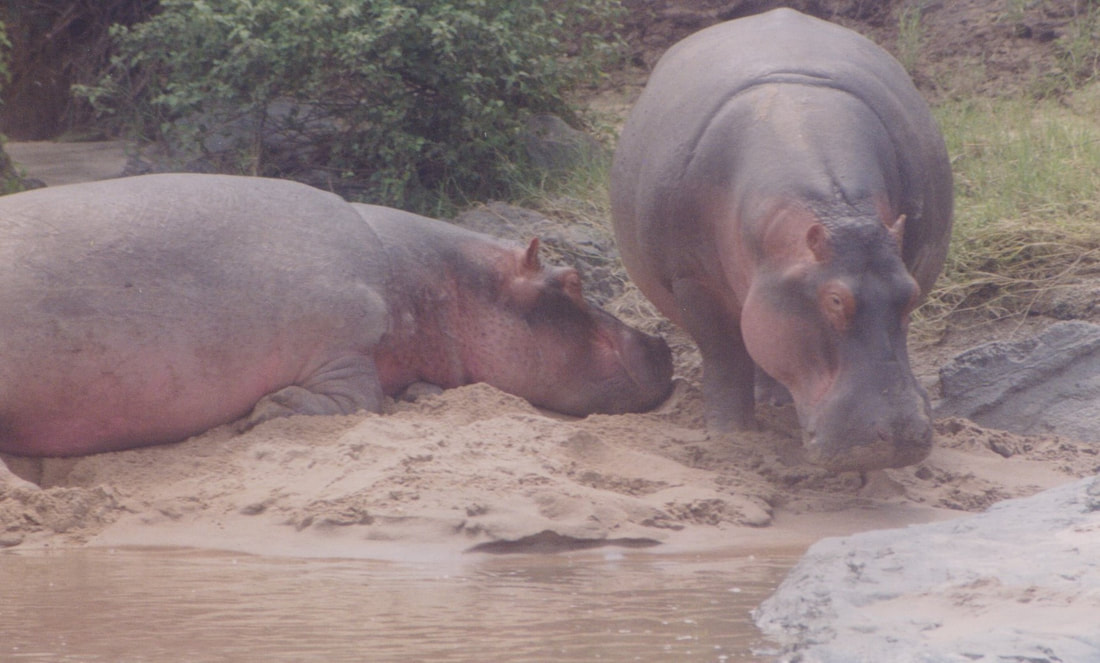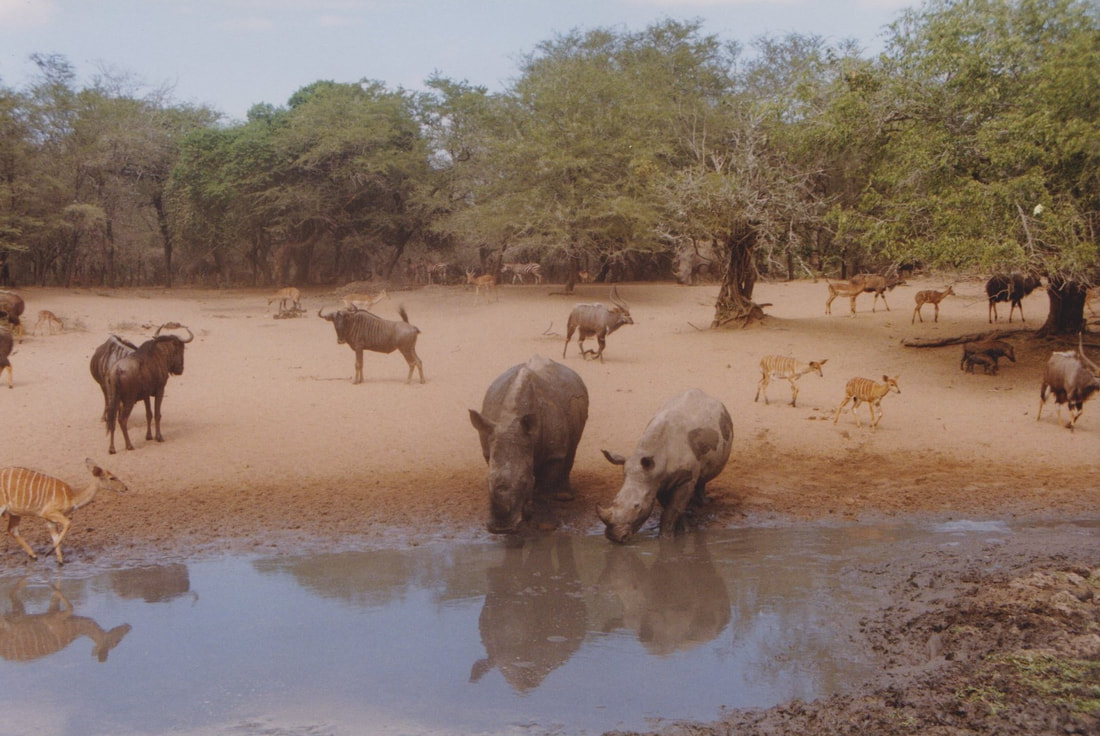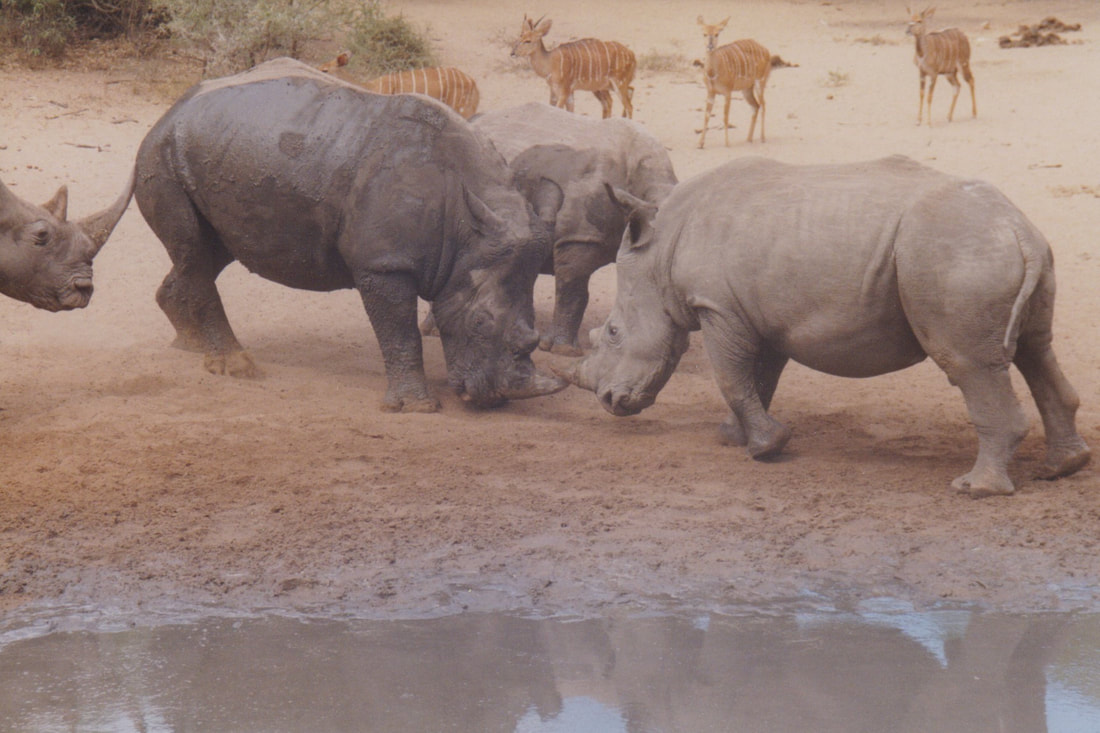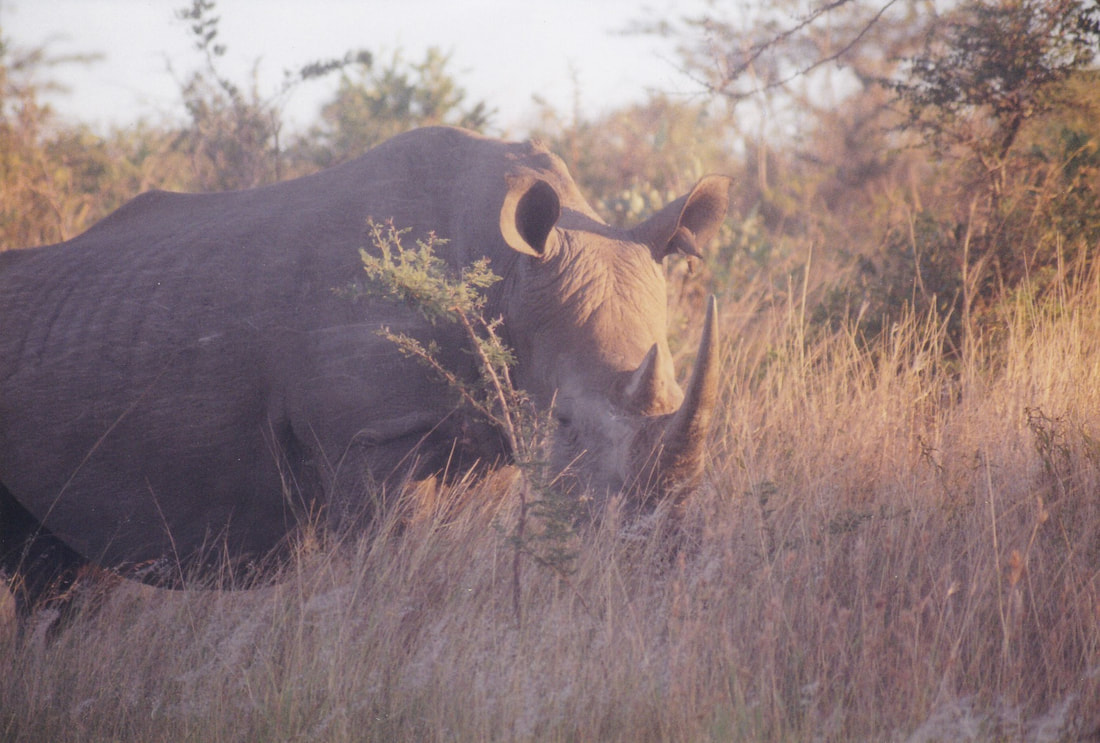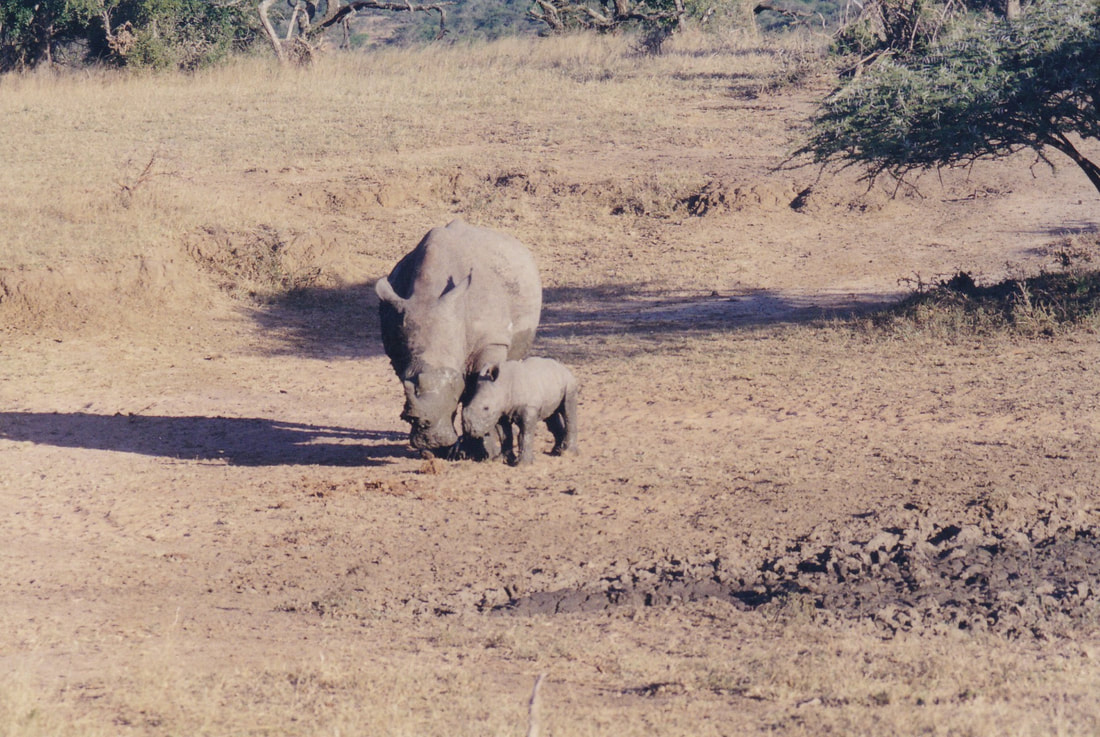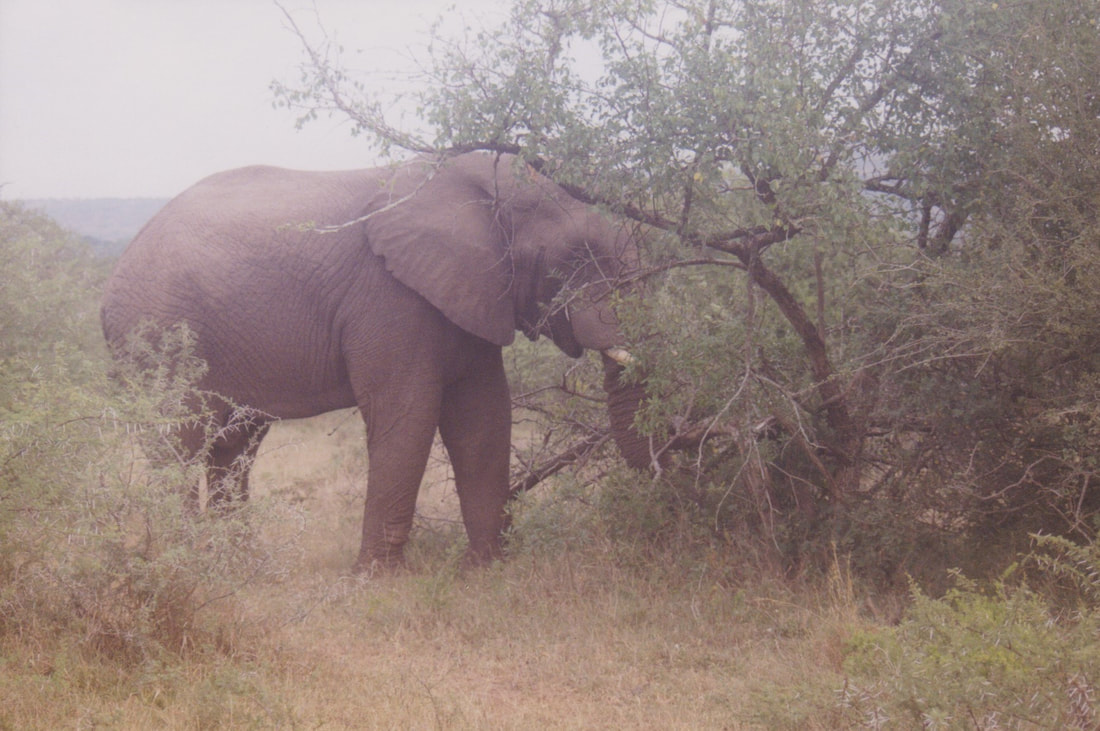|
* The next few posts will deviate a little from my normal format and represent a bit of nature travel escapism for those of us feeling a bit cooped up these days. The previous episode ended with the completion of field work in the midland region of KwaZulu-Natal, South Africa Fact: the hippopotamus is the most dangerous animal in Africa, responsible for killing more people than any other animal. (Note: this doesn’t include diseases carried by vectors like mosquitoes, or the much more dangerous Homo sapiens). This particular fact was at the forefront of my mind as I watched a pair of hippos slip under the surface of the water about 100 meters away from where I stood. Being this close to hippos wouldn’t have been cause for alarm under normal circumstances, but the circumstances at the moment were far from normal. The primary issue was that I and four companions were in a 20-foot aluminum motorboat named Vixen that was stuck in the middle of a giant, sluggish, milk-chocolate colored river teeming with hippos. Why are hippos so dangerous? It comes down to two things: a rather prickly disposition and meter-long teeth. And unfortunately for those of us stuck in the boat, one thing that really cheeses off hippos is unwanted visitors dallying in their territory, making a ruckus. At the boat’s helm, and the one responsible for our current predicament, was an overly confident South African man named Greg who now found himself at risk of incurring not only the wrath of the local hippos, but that of his girlfriend Karina as well. Ben, Justin, and I had met the couple the day before while touring around the terrestrial portion of the iSimangaliso Wetland Park (formerly known as the Greater St. Lucia Wetlands Park) in northeastern South Africa. Greg and Karina were sitting on the roof of their Land Rover looking out over a small pond, and when we stopped to watch some waterbuck foraging at the water’s edge, the couple invited us to join them on their mobile viewing platform. We climbed up the ladder and sat down, enjoying the views that the elevated station afforded us. We chatted with the two friendly South Africans, who were probably in their late 30s or early 40s, and they asked if we would like to join them on their boat the following day for a trip up the St. Lucia estuary. This sounded like an opportunity we couldn’t pass up, so we enthusiastically agreed, and arranged for a time to meet them the next morning at the boat ramp. When we arrived at the boat launch, they had just finished getting the boat in the water, and we jumped aboard, excited by the prospect of seeing some aquatic wildlife up close. Karina, who was the owner of the boat, had acquiesced to Greg’s desire to play captain, and he jumped behind the boat’s wheel. We motored away from the shore and began heading up the estuary. Despite admonitions from Karina to be careful of hidden shallow areas and to stay in deeper water on the right side of the estuary, Greg managed to captain us right into the mud in relatively short order. After a thoughtful assessment of the situation, the skipper decided that the obvious solution to the problem was to rev the motor even more and power us through the unseen mud shoals. Instead of skimming to freedom, we bogged to a whining halt with the propeller now caked in thick, sludgy mud. This was around the time that I noticed the hippos vanishing from sight and began wondering about their abilities to navigate through mud, and if they might be mollified by the sacrificial offering of our wayward captain. Another fun fact about hippos is that they don’t swim. They run, bound and gallop on the bottom, using fine buoyancy control to adjust how far from the bottom they go during their movements. Despite their tank-like proportions, they are quite graceful, and capable of reaching speeds up to 30mph in the water. Don’t believe that? Check out this video from a few years back: With my head full of useful hippo facts, various scenarios for how they would deal with us danced through my mind, and in none of them did the hippos offer to tow us out of the mud. To avoid padding the hippos’ grisly statistics, we began working on ways to extract ourselves. The boat had two small paddles that were nominally made from sturdy aluminum, but after attempting to use one to push us backwards through the mud I realized they were constructed from something akin to bendy-straw plastic. My paddle crinkled almost immediately, rendering it entirely useless. I didn’t want to appear as though I wasn’t trying to help, however, so I continued to act like I was working hard to free us with my now flexible paddle. When it became clear that we were not going to paddle ourselves to salvation, we stashed the paddles (I made sure to hide my crumpled paddle under some blankets), and we worked on developing other strategies. Justin came up with the idea of using the boat’s anchor to pull us back the way we had come. He would toss the anchor as far as he could, let it get nice and stuck in the mud, and then we would pull the boat towards the anchor. Once we reached the anchor, we would pull it up and repeat the process. It worked, and within half an hour we were able to get back to deep water. We all congratulated Justin on his brilliant idea, and our fearless captain again pointed us up the estuary, and away we went. We had no more unexpected adventures, but instead enjoyed a beautiful few hours watching hippos, crocodiles, goliath herons (the world’s largest heron), and a host of other wildlife. And I think we all very much enjoyed not being mangled to death. In classic “This is Africa” fashion, our hippo adventure was only one of many unforeseen wildlife encounters that happened on our trip. In fact, the prior day I had come face to face with an animal that I had never expected to see in the wild, nor had any idea of how to treat. As someone who had spent a good portion of his life outdoors and much of the indoor portions watching nature documentaries, I was unprepared to feel so, well, unprepared for that encounter. There are no lions in the iSimangaliso Wetland Park, so there are a few places where visitors can get out of their vehicles and walk through the bush. One of those is the Mziki Trail, and Ben, Justin and I were exploring sections of the trail that led to some animal hides overlooking waterholes. At one point I ventured off a little way from the other two, and slowly wound my way down a side trail. I spotted a Natal duiker (a German shepherd-sized antelope) bounding away through the vegetation. Not far behind was a young bushbuck (another medium-sized antelope) that was also making a hasty exit. I came to a stop. It wouldn’t have been unusual for two antelope to have run away from me, but they hadn’t exactly been running away from me. In fact, they had kind of been running towards me and then altered their course when they saw me in their path. I was trying to sort out what was going on when the answer came ambling around the corner about 50 feet down the trail. It was a honey badger. Those who are familiar with this large member of the weasel family know it is an animal not to be trifled with. Even though these wolverine-like animals only clock in at between 20 and 35 lbs, they have been known to take on lions and hyenas when defending a food source, and there are unsubstantiated reports of attacks on humans. They are also moderately indestructible. They have almost impenetrable skin, an incredibly thick skull, and an attitude that garnered them “world’s most fearless animal” in the 2002 Guinness Book of World Records. Furthermore, they have a sweet tooth for venomous animals. Well, I say sweet tooth, but I actually don’t know if venom falls on the sweet or salty side of things. Regardless, honey badgers routinely go after scorpions and venomous snakes like mambas, adders, and cobras. If an individual happens to get stung or bitten by one of these deadly meals, it might get a little sleepy and take a short nap, but then it’s up and raring to go again. So, this was the animal that was rapidly bearing down on me, making snuffling, huffing noises as it trotted along the path. Honey badgers do not have very good vision, and this individual’s attention was mostly directly towards the ground, so the prospect of having a close encounter seemed very real. Generally not one to panic, I instead froze, giving my best rendition of a tree or termite mound (my second-grade theater director would have been proud). I was at a complete loss for what to do. Climb a tree? Waive my arms and yell? I had no idea. Ultimately, I did nothing, and to my relief, when the honey badger was within 20 feet or so, it glanced up, saw me, appraised my level of tastiness, and pulled a quick U-turn. I breathed a sigh of relief, silently thankful that I didn’t smell like a big snake or some other animal from the honey badger menu. I think those people who write guides about what do to when bears attack, or when a shark is nibbling on your leg need to include a chapter on what to do when a honey badger is about to smack into you. I, for one, would find that helpful. We spent two days in the iSimangaliso Wetland Park, and then made the short trip over to the exquisite Hluhlewe-iMfolozi game reserve just off to the west. iSimangaliso had been great, but this was Africa on an entirely different level. Lion, elephant, Cape buffalo, hyena, rhinoceros, zebra, giraffe, leopard…the list of animals present in the reserve was staggering. We struck out on the cats, but we did get to see many other exciting game. The white rhinoceros was relatively abundant in the reserve, and we had a number of thrilling rhino sightings. One of our first encounters was with a massive male who wandered right up next to our car, giving us up-close views of his two-foot long front horn, and layered gray skin. There are two species of rhino: the white (or square-lipped) and the black (or hook-lipped), and white rhinos are much less ornery than their cousins. The white rhino’s broad mouths are used for grazing vegetation on the ground, while the black rhino’s pointed lips are more dexterous, allowing it to more effectively grasp leaves on bushes and shrubs. We watched the 2.5-ton male clipping grass along the edge of the dirt road for about 20 minutes, and when he had moved along a little, so did we. Towards late afternoon the next day, we came across a mother rhino and her very young calf standing at the edge of a small mud hole. Rhinos love a good wallow in the mud, and the baby had clearly been getting acquainted with this patch of mud. The mom stood watch while the baby bounded around her, testing out his new legs. Occasionally mom would herd him one way or another, using her horn to guide him in the desired direction. We were a good 100 meters away, but mom kept one eye on us and the other on the baby the whole time. After getting our fill of adorable baby rhino, we drove back to our accommodations and got our fill of pasta and beans. I’ll wrap up this post, as well as this three-part mini-series, with another elephant story. Warning: this elephant story is rated PG-13. We kicked things off a few weeks ago (Down in Africa: Part I) with an angry mother elephant threatening to crush us inside our Toyota Corolla. That experience gave us a very real appreciation for the sheer size and power African elephants possess. But in that case, it was mostly the potential for destruction that captured our attention. The day before that encounter we had witnessed the actual power that elephants are capable of when we came upon two large bull elephants foraging just off of the dirt track we were driving. We saw evidence of their presence long before we laid eyes on them; downed branches, massive dung piles, and trees knocked about like small saplings. The two bulls did not differ dramatically in size, but one, clearly the older, dominant male, had tusks that were much larger than those of the other, younger bull. The two males slowly made their way through the open savannah, grabbing branches with their trunks and shoveling the leafy vegetation into their mouths. At one point when the two elephants were perhaps 20 meters apart, there was a slightly surreal display put on by the younger bull. I have no idea what precipitated this show, but elephants do communicate in the infrasound range (below our hearing capacity) so it’s entirely possible the older bull said something disparaging to the younger one about the size of his tusks. Whatever was said, the young bull responded with the most unambiguous exhibition of machismo I have ever seen; he began thumping his own belly with his extended penis. Think male gorilla pounding his chest, only not using his hands. We were 100, maybe 150 meters away and could hear the thumping clear as day. I’m no elephant, but I certainly understood what was being said. I wondered if perhaps things would escalate and we would get to see these two behemoths grapple for dominance, but the older bull was unfazed by this youthful display of testosterone, and continued leisurely stuffing food into his mouth.
Just another day in Africa. Next post: nesting ecology of birds. Subscribe to the Newsletter! If you would like to get notifications about when new posts are up and other tidbits related to the blog, sign up for the View Out the Door twice-monthly newsletter. Just email viewoutthedoor “at” gmail “dot” com with the subject header SUBSCRIBE.
0 Comments
Leave a Reply. |
About the author:Loren grew up in the wilds of Boston, Massachusetts, and honed his natural history skills in the urban backyard. He attended Cornell University for his undergraduate degree in Natural Resources, and received his PhD in Ecology from the University of California, Santa Barbara. He has traveled extensively, and in the past few years has developed an affliction for wildlife photography. Archives:
|
